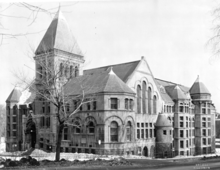Percy Erskine Nobbs
| Percy Erskine Nobbs | |
|---|---|
| Born |
August 11, 1875 Haddington, Scotland |
| Died |
November 5, 1964 (aged 89) Montreal, Quebec |
| Occupation | Architect |
| Buildings |
McCord Museum Osler Library, McGill University St. James Church, Trois Rivieres, QC |
Percy Erskine Nobbs (August 11, 1875 – November 5, 1964) was a Canadian architect who was born in Haddington, Scotland and trained in the United Kingdom. Educated at the Edinburgh Collegiate School and Edinburgh University, he spent most of his career in the Montreal area.[1] Often working in partnership with George Taylor Hyde, Nobbs designed a great many of what would become Montreal's heritage buildings and was a key Canadian proponent of the Arts and Crafts Movement in architecture.
Architecture career
He designed the fire station on Euston Road, in the "Arts and Crafts" style. It was built in 1901-2 and still stands. Nobbs had already received awards and won prizes as a practicing architect when he came to McGill University in 1903 to teach architecture. He got the permission to practice architecture while teaching, and soon obtained commissions for private homes as well as for institutional buildings. His designs for homes had the distinction of paying a great deal of attention to the siting and orientation of the building, and the placement of the windows. He considered this at least as important as what the home actually looked like. He called it "building for Prospect as well as Aspect," and designed many an impressive mansion in this way.
In partnership with Cecil Burgess, Percy Erskine Nobbs designed the J.B. Porter House on McTavish Street, Montreal, which has been demolished.[2]
Projects
He designed the interior decorative program of the Currie Hall at the Royal Military College of Canada in Kingston, Ontario. The Currie Building decorations evoke the achievements of the Canadian Corps in the Great War, and with the British Monarchy.[3]
Nobbs and Hyde designed many McGill University buildings: Power House (1909); Strathcona Medical Building (1923); Pathology Building (1923); Pulp & Paper Research Institute (1927). Nobbs and Hyde remodeled many McGill University buildings: MacDonald Engineering Building, reconstruction after fire in 1907; major addition to the University Library, McTavish Street (1921–22); addition of West Wing at Royal Victoria College (1930–31). Nobbs and Hyde provided interiors and furniture for the Osler Memorial Library (1923).
Nobbs and Hyde designed some commercial buildings around Montreal as well as the University Club building (1913) on Mansfield Street.
Nobbs and Frank Darling designed the master plan for the University of Alberta 1909-10. With Cecil S. Burgess, Nobbs designed the Provincial College of Medicine (1920–21). Nobbs designed the Arts Building (1914–15); laboratories and Power House (1914); [4]
Nobbs and Hyde won the competition for the war memorial in Regina.
| Building | Year Completed | Builder | Style | Location | Image |
|---|---|---|---|---|---|
| Arts Building, University of Alberta [5] | 1909-10 | Percy Erskine Nobbs & Frank Darling | Romanesque Revival architecture | Edmonton, Alberta |  |
| Pathological Institute Building, McGill University | 1925 | Percy Erskine Nobbs | Romanesque Revival architecture | Montreal, Quebec |  |
| Osler Library, McGill University | 1925 | Percy Erskine Nobbs | Romanesque Revival architecture | Montreal, Quebec |  |
| Redpath Library Building, McGill University | 1935 | Percy Erskine Nobbs | Romanesque Revival architecture | Montreal, Quebec |  |
| Currie Hall, Royal Military College of Canada | Percy Erskine Nobbs | Romanesque Revival architecture | Kingston, Ontario |  | |
He was an accomplished athlete in fencing, representing Canada at the 1908 Olympics[6] and for all of his life he was a true fisherman and founded the Atlantic Salmon Federation due to his love of fishing. He published two books, now both out of print, entitled Fencing Tactics and Salmon Tactics. His talent as a draftsman and painter—he was an RCA—was also quite exceptional.
References
- ↑ http://cac.mcgill.ca/nobbs/
- ↑ Norbert Schoenauer "Domestic Architecture"(1923-2001)
- ↑ Canada's Historic Places
- ↑ http://dictionaryofarchitectsincanada.org/architects/view/1452 Percy Erskine Nobbs
- ↑ http://dictionaryofarchitectsincanada.org/architects/view/1452
- ↑ "Percy Erskine Nobbs Olympic Results". sports-reference.com. Retrieved 2010-04-03.
| Wikimedia Commons has media related to Percy Erskine Nobbs. |
Further reading
- Lauder, Adam (Summer 2010). "Biopolitical Landscapes: The Preservation Tactics of Percy Nobbs". Future Anterior. 7 (1): 20–42. doi:10.1353/fta.2010.0001.
- Wagg, Susan (1982). PERCY ERSKINE NOBBS Architect, Artist, Craftsman. Kingston and Montreal: McCORD MUSEUM, McGill University by McGILL - QUEEN'S UNIVERSITY PRESS. ISBN 0-7735-0395-1. Retrieved 2008-04-26.
- "Legacy of Nobbs". McGill Engineering School of Architecture. McGill.ca. 2006-09-27. Retrieved 2008-04-26.
External links
- Historic Places in Canada
- History Writ Large: The Architecture of Percy Erskine Nobbs (John Bland Canadian Architecture Collection)
- The Canadian Encyclopedia
- Architects and Artisans: Canadian Art 1890–1918 (National Gallery of Canada Exhibition, 2013-14)
| Cultural offices | ||
|---|---|---|
| Preceded by Frederick Stanely Haines |
Acting President of the Royal Canadian Academy of Arts 1942-1943 |
Succeeded by Ernest Fosbery |